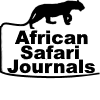A few minutes later, we found elephants. The closest of the three were probably about 10m from the road. They were very docile, gently eating and not bothered by the vehicles at all. This is not always the case in the Kruger Park South Africa - from personal experience we have learnt to always treat these giants with respect. But this was only the beginning...
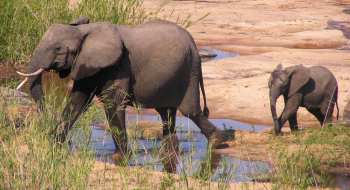
| An early start |
Bruce and I joined my sister and her family for a self-drive day visit in the Kruger Park South Africa. We had not planned to go but accepting their last minute invitation proved to be very fruitful indeed.
We love the Park and don't really need any excuse to go and the fact that we live only 1 hour's drive from the Malelane gate*, making it possible to visit often.
We set off from Barberton town at 5am and reached the gate just in time, pity it was school holiday and a public holiday to boot as there was a queue of about 15 cars waiting for the 6am gate opening (gate times vary depending on the month).
While waiting in the queue, we enjoyed some coffee and rusks that we had packed, and saw our first wildlife - predictably impala, and an African fish eagle - across the Crocodile river on the inside of the Park border.
| Pre-breakfast game drive |
At 06:45 we could finally start our Kruger Park South Africa game drive. We headed north towards Skukuza* and it wasn't long before we spotted our first "proper" game -
- (Impala is a lovely antelope but there are so many in the Kruger Park South Africa that you don't really stop to look at them any more nor try to count them. They have earned the nickname "McDonalds" buck as they are the fast food of the predators and also because of the black arches on their behind, similar to the fast food chain's golden "M".)
- nothing less than one of the "Big 5" animals. It was a small herd of elephants grazing merrily alongside the road.
Not long after that another of the Big 5 - buffalo. Note it is the "Cape" or "African" Buffalo and not the "water" buffalo as I often see it referred to in journals and trip reports. The water buffalo (domestic and wild) occurs in Asia, Pakistan, India, Bangladesh, Nepal, Bhutan, Vietnam, Thailand, South America, North Africa and Europe and their horns are "flatter". The Cape Buffalo of Africa is bigger, heavier and has distinct thick horns curling back towards the head.
At first we thought there were about 3 but just to show that sometimes you need to hang around and be patient, more and more buffaloes emerged from the grasses, among them young calves. You do often see small groups and even lone buffaloes in the Kruger Park South Africa, but big herds are more typical.
One particular buffalo was straying from the herd and for some reason its body was shinier in the early morning sun. Wait... not a buffalo but a hippo! It obviously enjoyed its nocturnal grazing so much that it strayed a bit far from the water and now had to rush back to the river in broad daylight. Not something you see everyday!
On any game drive through the Kruger you will come across many different birds. I do like them but must admit, the LBJ's ("little brown jobs"), doves and the like do not interest me too much so I tend to only stop and identify bigger or more colourful birds (shame on me!).
We saw some pretty swallows and shortly afterwards, a brown snake eagle atop a tree. They are quite a common sight in the Kruger Park South Africa and fairly easy to identify with their large head and plain brown colour.
You have to keep your eyes peeled for all sorts of game and we almost missed the next animal, partly because of its size but also because it blends into its habitat so well. It was a family of dwarf mongoose, peeping out of their old-anthill-home and generally being cute.
There are a few different hornbills in the Kruger and next we saw the red-billed species. The yellow-billed hornbill ("flying banana") is slightly more common but you often find both at the Kruger Park South Africa's picnic spots, begging for your breakfast crumbs.
One of my favourite antelope is the kudu, or to be more specific the greater kudu. The adult bulls have magnificent horns and apart from their pretty faces seem to have meek characters. We spotted a group of females browsing on the leaves. There may have been more hiding behind the trees and bushes as is often the case with animals on game drives, but we saw only three.
| The endangered wild dog - a rare sighting, not just in the Kruger Park South Africa |
Just before the water hole "Rhino Pan" we saw a bunch of vehicles. Usually such a sight in the Kruger Park South Africa would mean lions or something similarly exciting, but being a busy day (people-wise), we didn't get too excited. We waited our turn and saw that it was one of Bruce's favourite animals (apart from the leopard): warthog.
I must admit I don't find them cute in the way you find a lion cub cute because they have hard hair, are usually quite muddy and the adult males have those ugly warts on the side of their face. But their behaviour can be cute.
Anyway, this was a big one so one could understand the interest and clicking cameras. However, another car passed us in the opposite direction and said that there were two wild dogs at the water hole! Well, we could find warthogs later on, but wild dogs certainly don't come around every day!
We "sped" (40km/h, the speed limit on dirt roads) to the water hole, coming across many other vehicles and would you believe, another large warthog along the way. Parked at the water hole were about 10 other cars so we squeezed in along the left of them.
That was a lucky coincidence, because the two wild dogs were to the left of the waterhole, munching away on what was left of an impala kill.
This was unbelievable luck. The wild dog is an extremely endangered mammal and a rare sighting in whichever park they occur. We go to the Kruger Park South Africa regularly and haven't seen any for ages. Now that we saw them again, they were even busy at a kill. Really special!
We couldn't see too much as they were hidden behind bushes a bit. But every now and again one or both would run off towards the water hole to drink or lie down in the water (cooling off?) to return to the kill once more.
It was strange to see only two dogs as they usually hunt in a pack. We assumed the rest of the pack went off to feed young ones at a nearby den. Then again, nature is unpredictable and there could also be another explanation.
Vultures appeared and circled the sky above us. Some descended and landed in a nearby tree, some on the ground near the kill. They were edging closer to the carcass, trying to chase the dogs away so that they could tear slithers of meat off the bones.
Eventually they got their way and what a sight to see - about 40 or more vultures (mainly Cape vultures) mobbed the carcass, a heaving body of beaks and talons. A lappet-face vulture arrived on the scene and it obviously carried a higher ranking among the birds as the others made way for it. It was quite intimidating as it opened its wings slightly to make itself look even bigger, resembling Dracula in his heavy black coat.
In the meantime the we saw the wild dogs finally take the high road off into the bushes.
This was not the end of the show as next (I realise this sounds unbelievable but it's true) a lone male lion appeared on the scene.
The vultures fled to the nearby trees, decorating them like macabre looking Christmas trees.
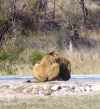
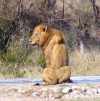 The lion didn't seem too interested in the carcass (perhaps there wasn't anything left). He turned to the waterhole. There he proceeded to drink litres and litres of water. He might have followed the vultures to the area, hoping for a few bites of free lunch (he was looking a bit thin) or perhaps he was coming to the water anyway and just so happened to stumble upon a (now old) kill and bunch of vultures.
The lion didn't seem too interested in the carcass (perhaps there wasn't anything left). He turned to the waterhole. There he proceeded to drink litres and litres of water. He might have followed the vultures to the area, hoping for a few bites of free lunch (he was looking a bit thin) or perhaps he was coming to the water anyway and just so happened to stumble upon a (now old) kill and bunch of vultures.
We decided to leave the water hole and on our way back to the tar road, saw a different male lion, thanks to another car which had stopped and its occupants looking into the bush with their binoculars. It was well camouflaged but every now and again we would see the movement of the large tawny body moving among the grass of the same colour.
| Time for breakfast |
We turned back onto the tar road to Skukuza and before long spotted some more elephants. They were very distant though and mere shapes on the horizon.
On a trip to the Kruger Park South Africa, we usually see quite a lot of wildebeest, but this day only one. It was lying under a shady tree all by itself. Not even a zebra or impala to keep it company.
Shortly before the Afsaal picnic spot, we spotted a family of warthogs to the left, grazing and running along the savannah grass.
It was 09:20 and time for breakfast. After 2½ hours of awesome game spotting in the Kruger Park South Africa, we have worked up quite an appetite.
The Kruger's picnic spots are well equipped and some, like Afsaal*, have shops and even offer light meals or coffee for sale.
We rented a gas cooker for R10 to cook our bacon and eggs on and ate it heartily, along with some bread, cheese, muesli, yoghurt and fresh paw-paw (papaya). We bought the food the previous day at a Barberton supermarket, a lot cheaper than inside the Kruger Park South Africa.
There is a local resident that we have come to know at the Kruger Park South Africa's Afsaal spot, being an African Scops-Owl. It is tiny and usually alone although it was joined by another a few months back (breeding?). Bruce & I have seen the Scops-Owl regularly at this spot on visits since October 2005 when we returned to the country and started making regular visits to the Kruger Park South Africa again. The staff usually put a sign on the ground below the owl so that it is easy for visitors to find and photograph it.
| Pit stop and turning point |
An hour and a half later at 10:45, we continued north on the tar road. There is a rocky outcrop to the right where we sometimes spot klipspringer. Klipspringers keep their mate for life and usually hang around together. We were lucky enough to spot the pair, lying on a rock in the shade.
Next we saw the first of quite a few bataleur eagles. You often see them flying overhead while driving around in the Kruger Park South Africa and are easily identifiable in flight because of their short tail and distinct under-wing black and white pattern.
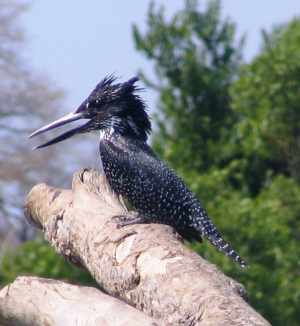 As mentioned before, you have to keep a sharp eye when seeking to spot game, and again we almost missed a small animal. This time it was a steenbok. It was standing still and is camouflaged so well in its Kruger Park South Africa surroundings, but luckily its shape triggered something in my brain.
As mentioned before, you have to keep a sharp eye when seeking to spot game, and again we almost missed a small animal. This time it was a steenbok. It was standing still and is camouflaged so well in its Kruger Park South Africa surroundings, but luckily its shape triggered something in my brain.
It's quite strange to only spot the first zebras this late in the day, but they were next on our Kruger Park South Africa game drive "agenda".
Three large white rhinos were next (another of the Big 5). It's always a thrill seeing these prehistoric animals. They can often look a bit confused as their hearing is good but their eyesight isn't, and they're probably wondering what the strange sound of a car engine is.
We made a pit stop at Skukuza's day visitors area (about 1km outside the main camp) where one can swim, have a picnic or just take a break from the heat. We bought some ice creams and cool drinks and afterwards took a drive across the low water bridge and back. This ensured we could add three nile crocodiles, one giant kingfisher (picture) and a pod of hippos to our Kruger Park South Africa game spotting list for the day.
From here we changed direction and started going back south.
| The stretch of road along the river, leading to Lower Sabie, Kruger Park South Africa |
We headed east on the H4-1 towards Lower Sabie camp and the sharp eyes of my niece spotted a of well camouflaged bushbuck among the shady trees, barely 3m from the road. They look so vulnerable and sometimes seem to freeze, looking at you looking at them.
Behind it was a small family of warthogs, doing what they do best: grazing.
After spotting another Bataleur flying overhead, we saw a few vervet monkeys alongside the road - some in the trees and other on the ground. I can watch them for hours especially if there are little ones around. Around the Kruger Park South Africa camps and picnic spots they can be a bit of a nuisance. It's mainly due to people feeding them, the animals then becoming expectant of it and turning into aggressive thieves. This is why we shouldn't feed wild animals.
We continued along this road which runs all along the Sabie river (usually a good place to be in the dry season as animals come down to the river to drink). One of the most elegant-looking ungulates in the world: giraffe. From its long eyelashes to its long swishing tail, it is a sight to behold.
We reached the T-junction with the H-12* road, where there is also a long bridge over the wide river. We were held up somewhat (anytime!) by a herd of elephants which were making their way to the water. Others were already at the water and others still, already on the other side. We took a drive across the bridge and back and saw a cute baby following its mom who was sporting a pair of uneven tusks.
Their and some of the other eles' bodies were partly wet, a sign that they had just enjoyed cooling themselves down by spraying water across their backs. The temperature in the Kruger Park South Africa this day was in the high 20's (°C).
That is also a spot where we saw chacma baboons, as we often do. The troop must live in the area. There were big and little ones, lazy and playful ones. The baboon is the only animal that can see into the car and distinguish you, the human. Other animals just see the car outline, some weird big harmless "animal". It's always a good idea to wind up your windows a bit and not show (or worse, give) them any food. Ever heard the phrase "cheeky monkey"?
We drove on and were blessed with more kudu (3 bulls browsing right next to the road), giraffe, buffalo (only three this time), more baboons and some waterbuck lying in the grass.
A Kruger Park South Africa guide once told us where the latter got its name from. Apparently when Dr Livingstone saw a magnificent bull on his explorations of Africa he exclaimed to the locals "What a buck!" True or not, it's certainly amusing!
After another shy bushbuck ram, we came across a bunch of helmeted guineafowl. Their beautiful spotted feathers and blue heads make for some pretty photographs against the pale colours of the dry Kruger Park South Africa landscape. They're usually scratching on the ground like chickens, looking for insects. They're supposed to fly up into trees or away when threatened but strangely enough don't, when you approach by vehicle. They rather prefer to stay in the road ahead of the car, resembling a fugitive trying to escape a police car by foot, you know the type of movie...
This day we weren't spoilt by the most recognisable of all sounds in Africa, but did see more of the bird which the call belongs to: two African fish eagles in a tree on the far side of the river.
The road delivered its silent promise and before reaching the Sunset Dam of the Kruger Park South Africa, we came across a lone vulture, more elephants in the river bed, vervet monkeys, kudu, another vervet monkey perched on top of a tall tree, warthogs, another fish eagle, a large herd of elephants (about 50) and within 100m of it, a large herd of buffalo (about 200), kudu bulls, a lone elephant bull, kudu ewes and another lone elephant.
That was the order in which we spotted them and probably over a 15km stretch of road.
| Sunset Dam, Lower Sabie - hippos and crocs guaranteed |
The Sunset Dam is one of the Kruger Park South Africa's best spots to sit and enjoy watching hippos and crocodiles - they are always there and the hippos can get quite vocal in the late afternoon. We stopped only for a few minutes as we were getting thirsty again and needed to keep an eye on the time for our exit of the Kruger Park South Africa.
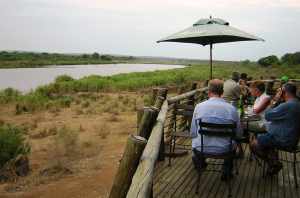 Apart from the usual characters we also spotted a troop of baboons, a family of warthogs, more guineafowl and a yellow-billed stork. There were other birds too but we didn't identify them.
Apart from the usual characters we also spotted a troop of baboons, a family of warthogs, more guineafowl and a yellow-billed stork. There were other birds too but we didn't identify them.
At 16:30 we drove through the Lower Sabie* camp gates and while enjoying our drinks on the beautiful deck, saw a number of crocs and hippos as well as some birds. Some people bring their books or binoculars and just enjoy the tranquillity and awesome view that the deck offers.
My sister and her family were spending the night here (I must admit, it's also my favourite Kruger Park South Africa camp) but Bruce and I had to get a move on to reach the Crocodile Bridge gate by the closing time of 6pm.
We said our goodbyes and soon after leaving the camp, we spotted more elephants (about 10) along the river, a lone giraffe, another fish eagle and, you guessed it, another elephant.
| Completing an already wonderful day in the Kruger Park South Africa - the leopard |
We saw a gathering of cars in the road and were spoilt with an amazing sighting. A female leopard and her cub were lying in the shade about 5m from the road. They were well hidden and I doubt we would have spotted them if it weren't for the other cars. This is really amazing as the leopard is elusive and often the one of the Big 5 that people don't see on a self-drive visit to the Kruger Park South Africa. To spot a cub is even rarer and a first for both Bruce and I.
The cats must have realised this as they put on a special show for us. The female got up, walked along the row of cars and then hurriedly crossed the road, with her cub following closely behind. It was such a privilege to see the cat move and out in the open!
Most people were satisfied by this and drove on. We were one of only two cars left behind, trying to spot the leopards again somewhere among the grass. The next moment we saw them climbing into a tree, a good 30m into the bush. They took a few minutes to find the most comfortable branches, then lay down for a peaceful nap and completing their show to us.
| Racing against the clock... |
Well now we were extremely satisfied and ready to go home. Seeing a leopard is always a bonus to me - not because it completes the Big 5 spotting for the day but because it is such a beautiful cat and so elusive.
It was starting to get late and we were heading south, hardly stopping for a white rhino. When we came across a herd of elephants we had to stop whether we wanted to or not, as they were crossing the road and taking their time doing so.
Even though we saw quite a number of elephants already, we enjoyed watching them again. There was a tiny calf, still able to move in under its mom's belly (meaning it's less than 1 year old) and as these were close to and in the road we got the opportunity to see detail on their huge bodies - like the folds in their skin, their huge and seemingly soft eyes, how they use their trunks to smell and eat... I could write a whole chapter on watching elephants. I love them.
There was no more time to stop and view animals. The clock was nearing 6pm.
But the Kruger Park South Africa wasn't finished with us yet! Along a straight stretch of road there was a bare section and there in the open lay two lionesses. One got up, walked about 5m to the right and proceeded to do her business. You feel like you should look away but she seemed totally oblivious of the cars. We left them to enjoy their last snooze before their nightly activities.
Around the next bend we saw no less than eight giraffes moving across the savannah - what a beautiful sight in the light of the setting sun!
The day was already perfect, but the next sighting threw it into the category of a record day, at least in our books or anyone doing a self-drive in the Kruger Park South Africa.
A car had stopped and the man inside was looking to the left. We asked what he was looking at (it had to be good, as it was virtually 6pm already and both him and us needed to exit the gate round about then). He replied that there had been a leopard (!) in a certain tree which he kindly pointed out to us, but as the prey had dropped out of the tree, the cat came down to the ground too. By that time the low light was making it difficult to see anything, let alone a cat able to hide itself perfectly well in broad daylight.
We used the binoculars and searched the area at the base of the tree and it paid off: there it was, among the long grass, happily munching its dinner.
As I said earlier, to spot a leopard is a bonus, to spot two in a single day is just being spoilt!
| Farewell |
By this time we were almost exhausted by our good fortune during our brief visit to the Kruger Park South Africa and finally reached the Crocodile Bridge gate* where we were bade farewell by a family of three warthogs.
Until next time.
| Rating |
On a scale of 1-10, this is a definite 10 - despite being busy people-wise (something we usually try and avoid).
We strongly believe the timing had something to do with our excellent viewing pleasure. The bush was dry as the summer rains hadn't started yet, forcing the animals closer to the water holes and river bed.
It will take a long time to beat these kind of sightings in the Kruger Park South Africa within a 12-hour period.
| Safari Location: | Kruger National Park, South Africa |
| Safari Company Used: | Self Drive |
| Duration: | 1 day, 25 September |
| Traveller Details: | Wilma Whittaker, South Africa |
| Rates & Availability: | Plan your own safari. Make a Kruger Park South Africa enquiry |
More Kruger Park Safari Reviews
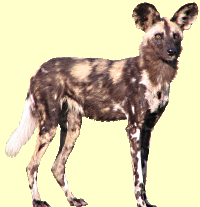
Back to the South Africa safari page or top

